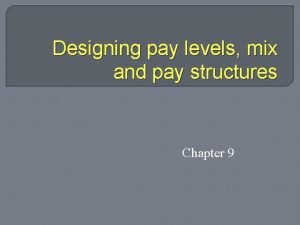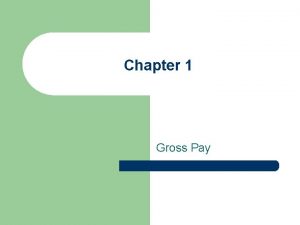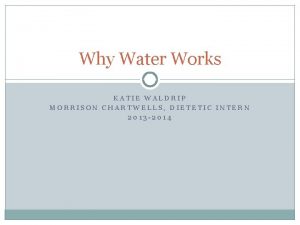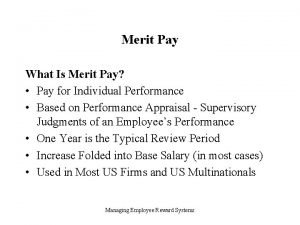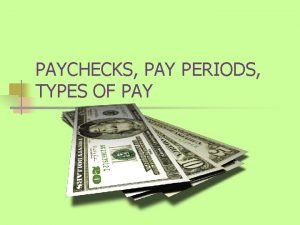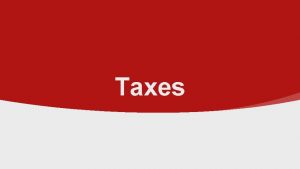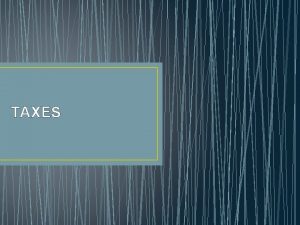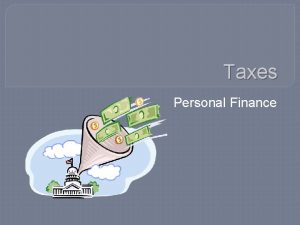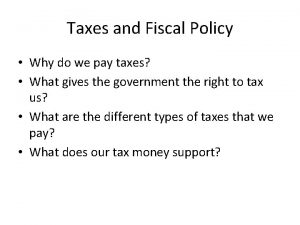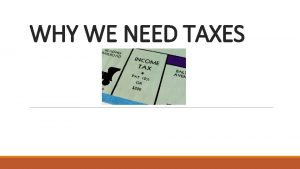TAXES WALDRIP WHY DO WE PAY TAXES The


















- Slides: 18

TAXES WALDRIP

WHY DO WE PAY TAXES? The government uses taxes to pay for things that most people use, such as roads, schools, libraries, police and fire protection. Taxes also pay for special programs like welfare and social security. There is sales tax on the things you buy, income tax on the money you make, property tax and other kinds of tax.

FEDERAL INCOME TAXES Social Security tax (6. 2%) is also called the FICA (Federal Insurance Contributions Act) tax. Social Security tax provides the following benefits for employees and their dependents: • Retirement benefits • Benefits for the dependents of retired workers • Benefits for the disabled and their dependents Medicare tax (Rate-1. 45%): is used to provide medical benefits for certain individuals when they reach age 65. Workers, retired workers, and the spouses of both are eligible to receive Medicare benefits upon reaching age 65. Federal income taxes (Varies according to your tax bracket): • National defense, veterans, and foreign affairs • Social programs • Physical, human, and community development • Law enforcement • Interest on the national debt

TYPES OF TAXES • Progressive • a tax whose rate increases as the payer's income increases. That is, individuals who earn high incomes have a greater proportion of their incomes taken to pay the tax • Regressive • is one whose rate increases as the payer's income decreases. • Proportional • tax system that requires the same percentage of income from all taxpayers, regardless of their earnings. A proportional tax applies the same tax rate across low-, middle- and high-income taxpayers.

PAYING YOUR FAIR SHARE (BRACKETS/EVASION/AUDITS) TAX BRACKETS

TAX EVASION

IRS AUDIT

FILING STATUS • • • Single Married person filing a joint return Married person filing a separate return Head of Household Qualifying widow(er) with a dependent child

EXEMPTIONS • What is an exemption? • reduce or entirely eliminate your obligation to pay tax • Personal exemption • If you are not claimed as a dependent on another taxpayer's return, then you can claim one personal tax exemption. This is a fixed amount that generally increases each year. The exemption reduces your taxable income just like a deduction does, but has fewer restrictions to claiming it. If you are married and file a joint tax return, both you and your spouse each get an exemption. • Dependent exemption • The IRS allows you to take additional exemptions for each dependent you claim. Frequently, the source of these exemptions are the children who live with you for more than half the year, are under 19 years old (or under 24 if a full-time student) and who don't provide more than half of their own financial support during the tax year. Some of your relatives can also qualify to be your dependents if they live with you and even your parents who don't.

W-4 FORM The purpose of Tax Form W-4 is simple ― it is used by your employer to withhold the proper amount of federal income tax from your paycheck. The IRS recommends that employees submit a new W-4 tax form each year, or any time their personal or financial situation changes.

W 4 EXAMPLE

WHO MUST FILE? • Whether or not you are required to file a federal income tax return depends on several things: • • your filing status, your age, your income, your dependency status

W-2 FORM The IRS requires employers to report wage and salary information for employees on Form. W-2. Your W-2 also reports the amount of federal, state and other taxes withheld from your paycheck. As an employee, the information on your W-2 is extremely important when preparing your tax return.

W 2 EXAMPLE

1040 A TAX FORM • Your taxable income must be less than $100, 000 to use the 1040 A. Your income can come only from these sources: • • Wages, salaries, and tips Interest and dividends Capital gain distributions Taxable scholarship and fellowship grants Pensions, annuities, and IRAs Unemployment compensation Taxable Social Security and railroad retirement benefits

1040 A EXAMPLE

1040 EZ TAX FORM You are eligible if: • taxable income is less than $100, 000 • you don’t claim any dependents • you file as single or are married filing jointly

1040 EZ EXAMPLE
 Paycheck
Paycheck O brother where art thou odyssey comparison
O brother where art thou odyssey comparison Neocalism
Neocalism Pictures
Pictures Designing a pay structure
Designing a pay structure Demotivators and edward deci
Demotivators and edward deci Lesson 1 hourly vs. salaried
Lesson 1 hourly vs. salaried Dont ask
Dont ask Pride and prejudice summary
Pride and prejudice summary Hình ảnh bộ gõ cơ thể búng tay
Hình ảnh bộ gõ cơ thể búng tay Frameset trong html5
Frameset trong html5 Bổ thể
Bổ thể Tỉ lệ cơ thể trẻ em
Tỉ lệ cơ thể trẻ em Gấu đi như thế nào
Gấu đi như thế nào Chụp phim tư thế worms-breton
Chụp phim tư thế worms-breton Chúa sống lại
Chúa sống lại Kể tên các môn thể thao
Kể tên các môn thể thao Thế nào là hệ số cao nhất
Thế nào là hệ số cao nhất Các châu lục và đại dương trên thế giới
Các châu lục và đại dương trên thế giới




